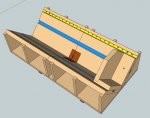- Messages
- 11,632
- Location
- Constantine, MI
I'm working on a small box with mitered corners and I want to add splines for both strength and aesthetics. I'll need to build a jig and I know these can be done either on the router table or table saw but I was curious as to which might be the better choice. Since I have yet to build the jig I am open to either.
What might be the advantages/disadvantages to each method? Which is safer? Which is easier to control? Does using a router bit insure that you will have a flat bottomed grove?
What does the collective say?
What might be the advantages/disadvantages to each method? Which is safer? Which is easier to control? Does using a router bit insure that you will have a flat bottomed grove?
What does the collective say?

 I agree on the fence and thin spline points. However...
I agree on the fence and thin spline points. However...



